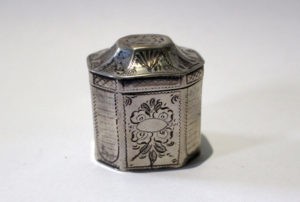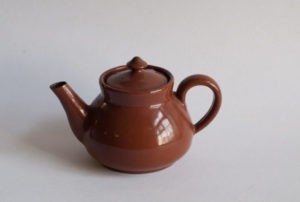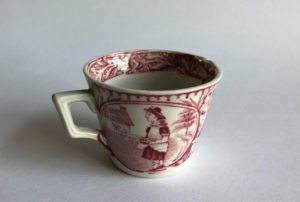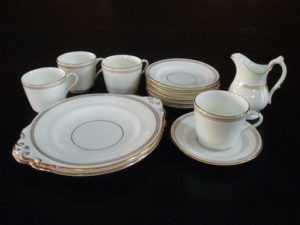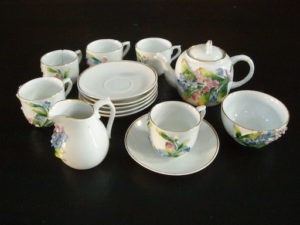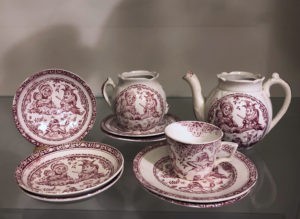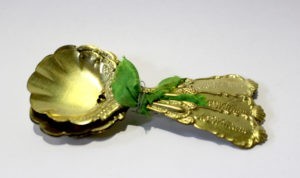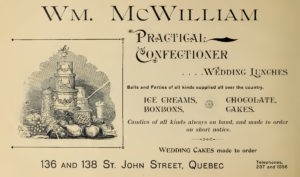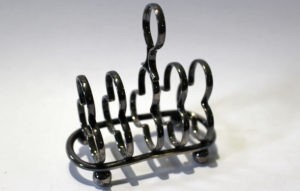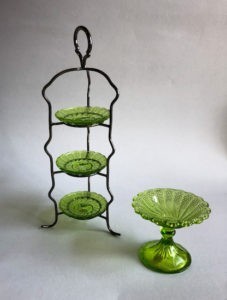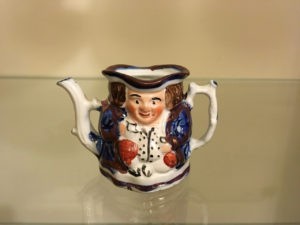China, which was collected by numerous households in the 19th and 20th centuries, was a reflection of wealth and social status. The Stephens Collection contains over 80 pieces of china from the 19th and 20th centuries that relate to serving tea, including several toy tea sets and objects intended for children.
The collection’s miniature “Punch and Judy” tea set was produced in Staffordshire in the 1880s. Punch and Judy puppet shows date back to 17th-century Britain. Mr. Punch typically wields a stick, which he uses to mercilessly beat others around him. This miniature tea set belonged to Jean Marsh, granddaughter of the first Baptist minister in Quebec City and daughter of the owner of Marsh’s shoe factory in Saint Roch. Jean Marsh was, in turn, the grandmother of author Louisa Blair, modern-day historian of Quebec’s English-speaking community, and David F. Blair, past president of the Literary and Historical Society of Quebec (1999–2012).
The collection also includes a “Toby” teapot. The name comes from “Toby Philpott,” a legendary roly-poly Yorkshire drunk from the 1700s who may or may not have ever existed. Usually sculpted downing ale from a large jug, Toby appears to be sipping tea in this child-friendly version. This teapot originally belonged to Louise Howard, a long-time Quebec City resident who worked at Price Brothers.
How about some toast to go with your tea? “To make dry toast properly, a great deal of attention is required; much more, indeed, than people generally supposed,” writes Mrs. Beaton in her Book of Household Management (1861). She thought a toast rack essential, ensuring airflow between slices to prevent them from getting soggy. This toy toast rack belonged to the children of the Breakey family. The Breakeys were Irish lumber merchants on Quebec City’s south shore who gave their name to the town of Breakeyville.
-
TOY TEA CADDY
1868, possibly the Netherlands
Silver
Belonged to the Scott and Breakey families
Stephens Collection 2004-291
4.1 x 4 x 3 cm
-
TEAPOT
Late 19th– early 20th century, unknown
Metal
Belonged to the Scott and Breakey families
Stephens Collection 2004-176
9 x 14 x 7 cm
-
TOY CUP
19th century, unknown
Ceramic
Belonged to the Marsh family
Stephens Collection 2004-305
5 x 8 x 6.5 cm
-
TOY TEA SET
c. 1870, unknown origin
China
Belonged to the Strang Family
Stephens Collection 2004-277
Various sizes
-
TOY TEA SET
c. 1890, probably Germany
Porcelain
Belonged to Aldythe Thom
Stephens Collection 2004-171
Various sizes
-
“PUNCH AND JUDY” TOY TEA SET
C. Allerton & Sons, after 1831, England
Porcelain
Belonged to Jean Marsh (Mrs. Fairley Blair)
Stephens Collection 2004-303
Various sizes
-
ICE CREAM SPOONS
McWilliam, c. 1890, Quebec City
Brass
Belonged to Connie Fraser
Stephens Collection 2004-174
1.4 x 10 x 3.8 cm
-
MCWILLIAM
CONFECTIONERS AD
1894, Quebec City
-
TOY TOAST RACK
Mappin & Webb, late 19th– early 20th century, England
Metal and silver
Belonged to the Scott and Breakey families
Stephens Collection 2004-177
8.7 x 8.4 x 3.9 cm
-
TOY DESSERT SET
Asprey, c. 1900, USA
Glass and silver
Belonged to the Breakey and Scott families
Stephens Collection 2004-288
Stand: 23.9 x 9.5 x 4.5 cm
Cup: 6 x 8 cm (diameter)
-
TOY “TOBY” TEAPOT
Allerton & Sons, c. 1875, England
Earthenware
Belonged to Louise Howard
Stephens Collection 2004-197
6.7 x 10.1 x 6.3 cm
Excerpts of writings by Mary Hilda Freeland Stephens:
“The bundle of four gilt spoons in The Collection was given to me by Miss Connie Fraser about 35 years ago when she was over 80 years old. She told me, ‘Old Mr. McWilliam gave me these spoons when I was about 10 years old. My father had taken me into the new John Street ice-cream parlour for a treat.’ The name ‘McWilliam’ is inscribed on each of the spoon handles.” (Mary Hilda Freeland Stephens, My Quebec Collection, 16)
“Valiquet’s store and McWilliam’s were my favourites, also Winfield’s; these were confectioners, so I was always given tastes of buns or candies. Of course, at McWilliam’s we often stopped for ice-cream in the ice-cream parlour. In “My Quebec Collection” I have a set of spoons tied with a green ribbon with McWilliam’s name on them. My mother remembered when she was young seeing a great cake leaving McWilliam’s store on a stretcher to be taken up to the Citadel for some celebration.” (Mary Hilda Freeland Stephens, Remembering a Quebec Childhood, 4–5)
“William [McWilliams]’s business establishment catered to the officers stationed in the Citadel in Quebec, the Lieutenant-Governor and his entourage, and to the social elite of Quebec. The business was established in 1850 and lasted for over one hundred years. At one time there were four stores in Quebec.” (Mary Hilda Freeland Stephens, My Quebec Collection, 17)
